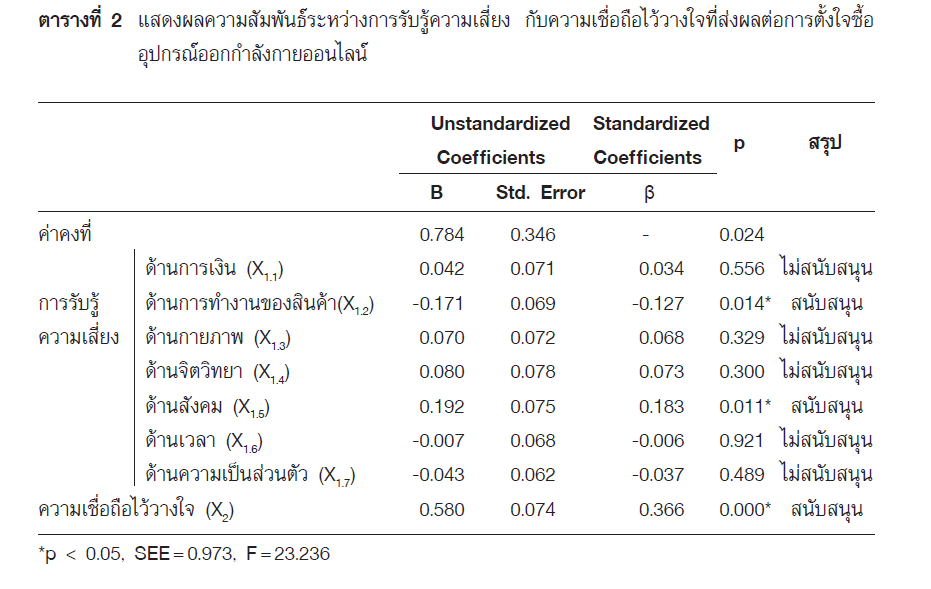THE RELATIONSHIP BETWEEN PERCEIVED RISK AND TRUST FACTORS AFFECTING INTENTION TO PURCHASE EXERCISE FITNESS EQUIPMENT ONLINE
Main Article Content
Abstract
Purpose :
The purpose of this study was to examine the relationships between perceived risk (namely financial risk, performance risk, physical risk, psychological risk, social risk, time risk and privacy risk) and trust factors and intention to purchase exercise fitness equipment online.
Methods:
A sample group of 400 people who had experienced in purchasing exercise equipment online were selected to respond to online questionnaires. The data analysis method consisted of percentage, frequency, standard deviation and multiple regression analysis. A statistical significance was set at p < .05.
Results:
The study found that performance risk had negative effect on the intention to purchase exercise equipment online. Whilst physical risk, psychological risk, time risk and privacy risk had no effect on the intention to purchase exercise equipment online. Lastly, the perceived social risk and trust had a positive effect on the intention to purchase exercise equipment online.
Conclusion:
The perceived performance risk, social risk and trust factors are likely to affect the intention to purchase exercise equipment. The findings are beneficial to entrepreneurs and those who are interested in exercise equipment business. They are urged to apply these results to target the market more successfully.
Article Details
References
Ajzen, I. (1991). The theory of planned behavior. Organizational Behavior and Human Decision Processes, 50(2), 179-211.
Cheung, C. M. K., and Lee, M. K. O. (2001). Trust in internet shopping: Instrument development and validation through classical and modern. Journal of Global Information Management, 9(3), 23-35.
Cochran, W. G. (1977). Sampling techniques (3rd ed.): New York : John Wiley and Sons.
Corbitt, B. J., Thanasankit, T., and Yi, H. (2003). Trust and e-commerce: a study of consumer perceptions. Electronic Commerce Research and Applications, 2, 203-215.
Cox, D. F., and Rich, S. U. (1964). Perceived risk and consumer decision-making - The case of the telephone shopping. Journal of Marketing Research (JMR), 1(4), 32-39.
Divine, R. L., and Lepisto, L. (2005). Analysis of the healthy lifestyle consumer. Journal of Consumer Marketing, 22(5), 275-283.
Flavián, C., Guinalíu, M., and Gurrea, R. (2005). The role played by perceived usability, satisfaction and consumer trust on website loyalty. Information and Management, 43, 1-14.
Gefen, D. (2002). Reflections on the dimensions of trust and trustworthiness among online consumers. Database for Advances in Information Systems, 33(3), 38-53.
Hong, I. B., and Cha, H. S. (2013). The mediating role of consumer trust in an online merchant in predicting purchase intention. International Journal of Information Management, 33, 927-939.
Klein, L. R. (1998). Evaluating the potential of interactive media through a new lens: search versus experience goods. Journal of Business Research, 41(3), 195-203.
Mayer, R. C., Davis, J. H., and Schoorman, F. D. (1995). An integrative model of organizational trust. Academy of Management Review, 20(3), 709-734.
Oppatum, P. (2013). Thrust and characteristics of social commerce affecting the purchase intention via social media. Master of Business Administration, Bangkok University.
Pavlou, P. A. (2003). Consumer acceptance of electronic commerce: Integrating trust and risk with the technology acceptance model. International Journal of Electronic Commerce, 7(3), 101-134.
PayPal. (2017). Ipsos report 2016: Thailand ranks second out of APAC ( Onli ne). Retrieved February 2, 2018, from Paypal Website: https://www.paypal.com/stories/sea/paypal-ipsos-report-2016-thailandranks- second-out-of-apac
Pi, S.-M., and Sangruang, J. (2011). The perceived risks of online shopping in Taiwan. Social Behavior and Personality: an international journal, 39(2), 275-286.
Salam, A. F., Iyer, L., Palvia, P., and Singh, R. (2005). Trust in e-commerce (pp. 72). United States: ACM Association for Computing Machinery.
Thaweephorn, P. (2015). Factors positively influencing purchase intention of online supermarket A of the customers in Yan Nawa District in Bangkok. Master of Business Administration, Bangkok University.
Williamson, A. (2013). Social media guidelines for parliaments: Inter-Parliamentary Union.
Zheng, L., Favier, M., Huang, P., and Coat, F. (2012). Chinese consumer perceived risk and risk relievers in e-shopping for clothing. Journal of Electronic Commerce Research, 13(3), 255-272.


